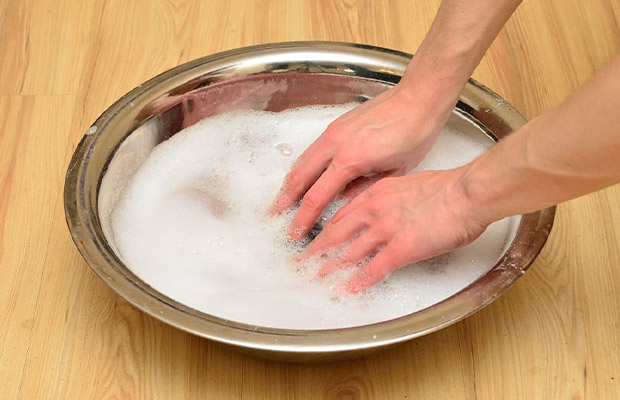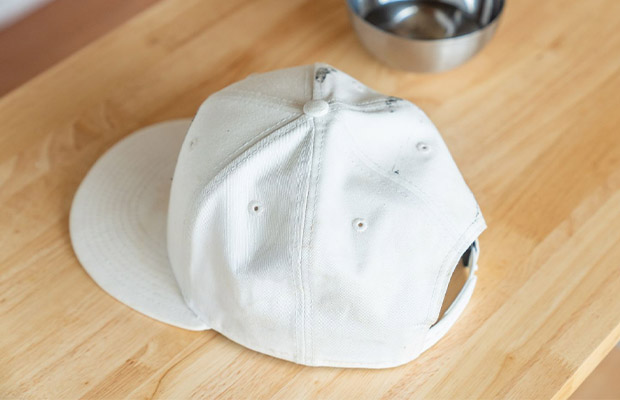In this article we’re going to go over the best cleaning method for white hat, what not to do during washing and how to keep your hat clean!
A bright white hat is exciting, new, and daring. Even if you take every precaution, stains will still occur on your white accessory. And they’ll discolor or dirty up your chic white hat. However, a stain does not indicate that you should retire your white cap permanently. A white hat can be cleaned so that it once again looks stylish.
How to clean a white hat? There are many ways you can use, one is using distilled white vinegar as you would with hydrogen peroxide. Apply it to the stain, let it sit, rinse, and then let it air dry. Keep reading and learn more details about different washing methods.
Table of Contents
Before You Wash
Before getting out the soap and water, there are a few things you need to know. The fate of your hat is at stake.
Look At Labels
Reading the label on your hat will inform you of what you are wearing and how to care for it, just as it is important to read food labels to know what you are eating.
Check the fabric and adhere to the washing instructions. Only more recent baseball caps have plastic brims or those made of washable materials, so if you have an old baseball cap, make sure it doesn’t have a cardboard visor.
If the label says “dry clean only,” take the hat to the dry cleaners and let the professionals handle it.
Bye-bye Bleach
Whether you decide to wash your hat by hand, give it a little spot cleaning, or throw it in the washing machine, one thing remains the same: Do not use bleach. Bleach has the potential to not only dissolve the fabric but also change the color of the hat and add new stains rather than remove old ones.
Ditch The Dishwasher
Despite the numerous online articles that advise against doing it, washing a hat in the dishwasher is a safe and simple alternative. Dishwashers are high-intensity machines that use hot water and hot drying cycles that will discolor, misshape, and shrink the fabric of your hat. A lot of dishwasher detergents also contain bleach.
How To Clean A White Hat? 6 Ways
There are various techniques for cleaning or removing stains from a white hat, depending on what the tag says. The best place to start when removing stains or cleaning your hat is with gentle methods. Then, if necessary, progress to other techniques if they are appropriate for the subject matter. The different ways to clean a white hat are listed below.
Method 1: Handwashing
The safest way to clean your hat is by handwashing, even though it takes longer and more work. However, some labels may state “dry-clean only.” Leave it to the experienced dry cleaners for a hat like that.
Hand washing is safe for some materials, including cotton, wool felt, and synthetics. Even though you’ll need to plan ahead, your preparation will be worthwhile in the end.
Washing Instructions
- Fill a bucket or sink with water. As it fills, mix 1 cup hydrogen peroxide, one tablespoon of laundry detergent or dish liquid, and one scoop of Oxiclean or baking soda
- Add the mixture to cold water to create wool felt. If cleaning cotton and cotton blends, use warm water
- Soak the hat for 30 minutes
- Using the soft-bristled brush, scrub the stains, grime, or dirt gently to avoid pulling on the fibers
- Rinse the hat in the same temperature water that you used to clean it. The water should be submerged, stirred, and then drained. Continue doing this until the rinse water is clear.
- Let the hat air dry inside or outside in the shade. Avoid exposure to direct sunlight because it can weaken the UV protection factor (UPF).

Method 2: Spot Cleaning
It’s not always necessary to wash the entire white hat to remove stains, especially if it has a delicate design. Small marks might disappear with spot cleaning. A white hat could be spot cleaned with only a few common household products. Do a spot test to make sure the cleaner won’t damage or discolor your accessory.
- Utilize a cotton swab, cotton ball, paper towel, or white cloth to apply hydrogen peroxide to the stain. Use a soft, clean toothbrush to work the hydrogen peroxide into the material. Let it sit in the hat for approximately 10 minutes, then rinse, let it air dry, and check to see if the stain is gone.
- Vinegar that has been distillate: Use white vinegar that has been distillate as you would hydrogen peroxide. Work it into the stain, then wait before rinsing and letting it air dry.
- Water should be diluted with a few drops of mild dish soap. Then, spot clean as you would with vinegar or hydrogen peroxide by dipping a clean, white cloth into the solution.
- Shampoo: Try spot cleaning with a mild shampoo that doesn’t contain any dyes. Spot test the shampoo after diluting it with water. After cleaning, let it air dry like you would with other cleaners.
- Make a thin paste out of baking soda and water. The mixture should be applied to the stains with a soft, clean toothbrush. Allow the mixture to sit for 10 to 15 minutes. Check to see if the stain is gone after rinsing the paste away and letting it air dry.
Your white hat won’t get any more stains by using a fresh, white cloth. Your white hat could become stained if you are wearing a colorful cloth, especially one that is brand-new. The grease or dirt on a dirty cloth might also transfer to your hat.
Some stains might require additional hand washing. If possible, wash your hat’s material in warm water and mild detergent. Use the techniques listed above to remove sweat-related yellowing, or consider using an enzyme-based stain remover. If you don’t want to soak the hat, mix the stain remover with warm water and spray it directly onto the stain.
Method 3: Brushing
Hats made of toyo or paper-braid or other woven materials typically do poorly when exposed to water. To get rid of dirt and dust, you’ll have to brush the surface. Stubborn dirt may be easier to remove if you use a brush with stiff bristles. Take care not to press too firmly as this could cause the hat to bend, scratch, or suffer other types of damage. If the dust and dirt are only surface-level, a brush with soft bristles will also work in place of one with stiff bristles.
Remove any hatbands or decorations before brushing a white hat to prevent crushing them. Use a hairdryer on low and cool settings to blow away dirt and dust if you are unable to remove the decorations from your hat.
You might think about using a cleaning solution if your straw hat has noticeable stains that are difficult to remove with brushing. Use a mild dish soap and water solution, after checking the tag to see if it’s okay to clean your hat with liquids. Do not soak a clean cloth in the mixture; just dip it in. Using a damp rag, gently rub the stain while following the pattern of the straw material.
Add cornstarch and let it sit for a few hours if your hat is white leather or has a leather interior band. If the material feels stiff, remove the cornstarch with a brush and condition it with leather conditioner.
Method 4: Machine Washing
You may be wondering if you can wash a hat in the washing machine because hand washing and spot cleaning take a long time to remove tough stains. Only a few styles of cotton clothing actually hold up to washing in a machine. Baseball caps with shapers and hats from the Tilley brand are suitable for machine washing because they have a lifetime warranty. Other designs, such as unformed choices or bucket and boonie hats, might also be appropriate.
Unsure if your hat will hold up in the washer? To maintain the shape of your hat, use spot cleaning and hand washing. If you can machine wash your white hat, follow these tips:
- Use laundry stain remover as a preventative measure.
- Make use of cold or cool water.
- Select a delicate or gentle cycle for your washing machine.
- Use a mesh bag made for delicate laundry to wash your cap.
- Either by itself or with white clothing, wash your hat.
The mesh laundry bag you choose should be large enough to accommodate your hat without folding or crushing it. You can find hat shapers made specifically for baseball caps, trucker caps, and snapback hats. Like the Ball Cap Buddy, these hat shapers are frequently made of plastic. It has a cage-like design that resembles a baseball cap and either opens to hold the hat or grabs hold of the front and brim. Always use a hat shaper when washing your hats in the washing machine.
Method 5: Bleaching
As a last resort, try using bleach on tough stains. If the tag on your hat says it’s okay to use, only use this cleaner. Bleach can damage some fabrics, causing your hat to become unwearable. Bleach should not be used on anything that is wool or has details made of silk or wood.
Use an oxygen-based bleach solution when cleaning a hat. The instructions on the cleaner’s package and the tag on your hat should always be followed. Oxygen-based bleach can be gentler than chlorine bleach, which could damage fibers.
Test a small area even if the tag on your hat says bleach is safe to wear. Examine the interior of the hat or any other concealed area. Check to see if the fabric’s color changes significantly over time by applying a small spot of bleach as instructed.
Once you’re certain that bleaching a white hat is safe, you can either hand-wash or machine-wash it. Add a small amount of bleach to the wash as directed for the machine. If you’re spot cleaning or hand-washing your hat with bleach, follow these steps:
- Bleach and water should be dissolved. The ideal ratio of bleach to water is frequently one part to two parts, but always check the bottle for instructions.
- For precise application, dab the solution onto the stain with a cotton swab.
- Spray the bleach solution on the stain.
- If the stain is difficult to remove, let the solution sit for five to ten minutes.
- If your fabric is more delicate, avoid letting the solution sit.
- Wash the hat by itself in the machine, hand, or after rinsing off the bleach.
Method 6: Professional Care
A white hat shouldn’t always be washed using household remedies. Professionals are available to assist in that situation. Research options for professional hat cleaning and maintenance in your area and see if they could help you with things like:
- Deep cleaning
- Set-in stains
- All-over stains
- Dingy appearance
If other hats have stains, you should bring them along as well since you’ll need professional care for the dry-clean-only hats.
What Not To Do When Cleaning A White Hat?
While understanding how to remove stains and dirt from your white hat is important, it’s equally important to know what you should not do while doing so.
There are false suggestions and quick fixes for cleaning hats, some of which could harm your hat permanently. When it comes to cleaning your white hats, here are some don’ts:
- Don’t wash your hat in the dishwasher. Shrinkage and fading could be brought on by the hot water and high pressure.
- Don’t use bleach, no matter how tempting. You might get a hat that is yellowed rather than stains that are removed.
- Avoid drying in the sun. Even though it moves more quickly and your hat might have UV protection features, the sun’s rays can still be potent enough to cause fabric fading and deterioration.
- Don’t dry in the dryer, too. It’s no surprise that clothes dry so quickly given the dryer’s high temperature. Your hat’s fabric, however, will be harmed.
- Keep in mind to check your hat and read the label. You can find washing instructions on the label, and by inspecting the item before washing, you can look for any damage like loose stitches or broken brims. The loose stitches might come out if you wash it without checking.
- If your hat is still wet, do not store it. Before drying, make sure the hat is completely dry. If not, it might start to grow mildew and smell musty. Additionally, avoid placing it in a plastic bag because moisture can collect there and lead to mold growth on the hat.
How To Keep Your Hat Clean In The First Place?
In many situations, it may be simple to clean a white hat, but if you have a delicate hat or want to prevent stains, learn how to keep your hat clean in the first place. You could avoid the hassle of cleaning stains off of a white hat by taking a few precautions.
- Pack it carefully—dropping your hat while traveling could result in stains. Your hat will be safe in your suitcase if you know how to pack it, but you must do it correctly. While some hats can be rolled, others must keep their shape. Put clean socks or rolled-up shirts inside the crown in those situations. If your hat won’t fit in a suitcase, ship it in a hatbox to keep it secure.
- Don’t sweat it: In the summer, hats are worn by a lot of people, but the heat causes sweating, and sweating stains a white hat. Try hat liners if you want to protect your hat while wearing one in the sun or while working out. These items are sticky patches that stick inside your hat and are usually disposable absorbent products. They can catch the sweat and keep it from seeping in and discoloring your hat.
- Consider where you are going: If you are going somewhere that is dusty or muddy, you might want to wear a darker hat. While you’re out and about, you wouldn’t want your white hat to fall or to get dirty. If your hat doesn’t fit snugly, you should also consider windy conditions. You don’t want to run after your white hat only to have it end up covered in mud.
- Take care when handling it: Make sure your hands are clean before putting on or taking off your white hat. You wouldn’t want to put on your hat only to discover after the fact that you have something on your hands that will leave a stain. Before putting your hat away, make sure the area where you keep it is tidy.
- After wearing, wipe it off, even if you don’t believe you sweated or that any dirt or dust got on your white hat. If the fabric of your hat permits it, take a white, damp, clean cloth. If the fabric shouldn’t get wet, wipe it with a dry cloth. After that, gently wipe the hat’s interior.
- Dry the interior band. Sweat or moisture may accumulate on the hat’s interior band after wearing. If you can, turn the band down after wiping it with a dry, white cloth. If you don’t have on your hat, this allows it to dry and air out.
Final Thoughts
The idea of successfully cleaning your white hat should no longer be intimidating after reading this article.
Once you have the necessary information and materials, the task is not too difficult. Cheers to you and your clean, new-looking white hat!
Read More:



MOST COMMENTED
How to
How to Clean Homedics Humidifier: Detailed Guide
How to
Are Humidifiers Good for Pneumonia? Complete Guide
How to
Can You Put Drano in a Dishwasher? (Facts & Safe Alternative)
How to
How to Turn Subtitles on Or Off on Peacock TV: 2023 Guide
How to
How to Get Rid of Hollow Arrow on iPhone? 2 Simple Ways
How to
How to Mirror iPhone to TV Without WiFi: Complete Guide
Computers, Tablets & Printers
The 5 Best Printers for Cricut in 2022